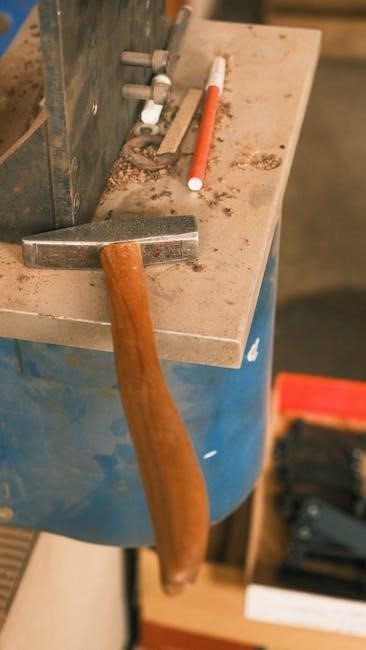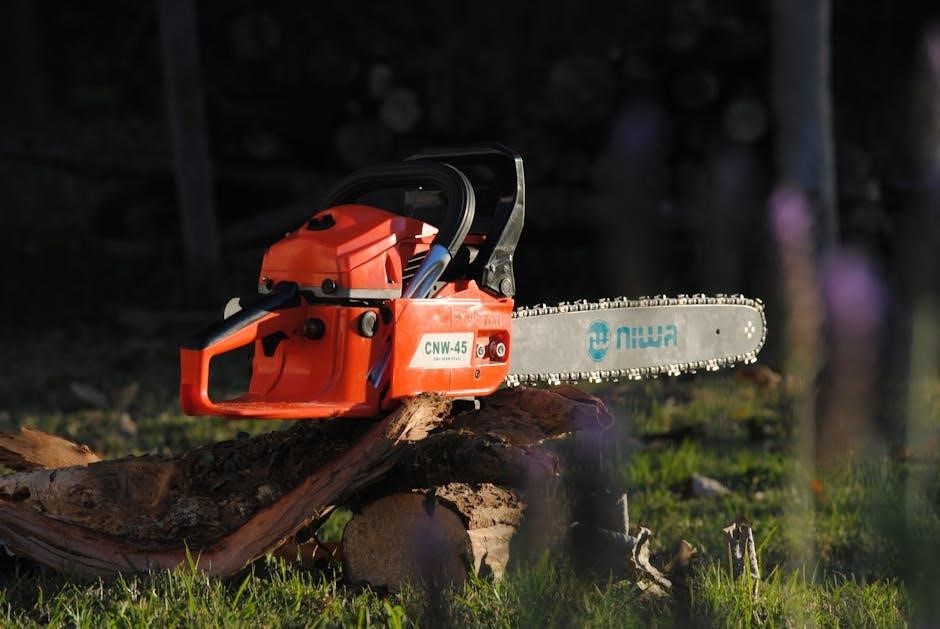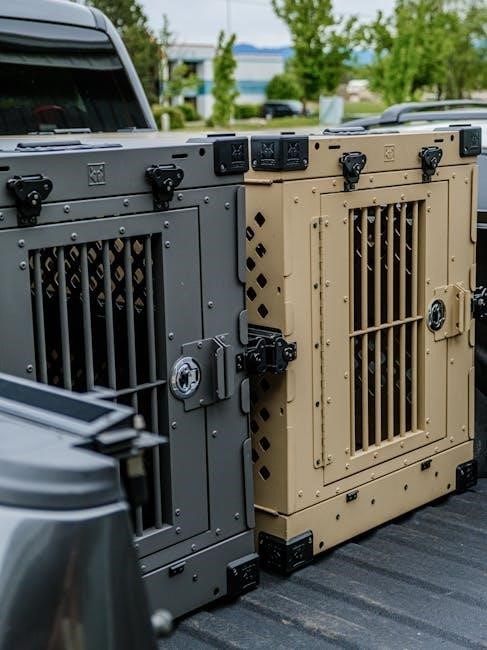
manual saw
Manual saws are essential tools in woodworking and various crafts, offering precision and versatility. They require skill and patience but provide unmatched control and sustainability.
1.1 Definition and Purpose
A manual saw is a handheld tool used for cutting various materials like wood, metal, or plastic. Its primary purpose is to make precise, controlled cuts without the need for electricity. Manual saws are essential in woodworking, crafting, and DIY projects, offering versatility, portability, and cost-effectiveness. They require physical effort but provide unmatched accuracy and sustainability for small-scale tasks, making them indispensable in both professional and amateur settings.
1.2 Historical Background
Manual saws trace their origins to ancient civilizations, with early versions made from bronze and used in Egypt and China. The Romans refined saw designs, introducing crosscut and rip saws. By the Middle Ages, saws featured steel blades, enabling finer cuts. The 18th century saw the rise of specialized saws like backsaws. Over centuries, manual saws evolved in design and materials, becoming indispensable tools in woodworking and craftsmanship, reflecting human ingenuity and the demand for precision cutting instruments.
Design and Components of Manual Saws
Manual saws feature durable blades made from high-carbon steel, ergonomic handles for grip, and mechanisms like tension screws for blade adjustment, ensuring precision and control in cutting tasks.
2.1 Blade Types and Materials
Manual saw blades are crafted from high-carbon steel for durability and rust resistance. Blades vary in tooth count and configuration, with rip saws (fewer, larger teeth) for straight cuts and crosscut saws (denser, smaller teeth) for precise, smooth finishes. Specialty blades, like dovetail or coping saws, cater to intricate cuts. The material ensures sharpness retention and ease of sharpening, making manual saws versatile for woodworking and metalworking tasks.
2.2 Handle Design and Ergonomics
Manual saw handles are designed for comfort and control, often made from durable materials like wood, plastic, or rubber. Ergonomic contours reduce fatigue, ensuring a secure grip during prolonged use. Some handles feature cushioned or textured surfaces to enhance traction, minimizing slippage. The design prioritizes balance, allowing precise manipulation and consistent sawing motion, which is critical for achieving accurate cuts in various materials and applications.
2.3 Mechanisms for Blade Tension and Adjustment
Manual saws often feature mechanisms for blade tension and adjustment, ensuring optimal rigidity and alignment. These mechanisms, such as screws, wingnuts, or tension knobs, allow users to tighten or loosen the blade as needed. Proper tension prevents wobbling and ensures straight cuts, while adjustment features enable alignment corrections for consistent performance across various materials and cutting techniques.
Types of Manual Saws
Manual saws come in various types, each designed for specific tasks. Handsaws, backsaws, and coping saws are popular choices, offering unique features for precise cutting and versatility.
3.1 Handsaws
Handsaws are versatile, portable tools used for various cutting tasks. They feature flexible blades and ergonomic handles, ideal for precise cuts in wood, metal, and plastic. Common types include rip, crosscut, and dovetail saws, each tailored for specific woodworking needs, ensuring efficiency and accuracy in both professional and DIY projects.
3.2 Backsaws
Backsaws are specialized manual saws with a reinforced spine, providing rigidity and straight cuts. Often used for fine woodworking, they excel in making precise joints and cuts in thin materials. The stiff design minimizes blade deflection, ensuring accuracy. Common types include tenon and dovetail backsaws, each designed for specific tasks, making them indispensable for craftsmen seeking high-quality finishes and intricate details in their workpieces.
3.3 Coping Saws
Coping saws are versatile manual saws designed for intricate cuts in thin materials like wood, plastic, or metal. Their flexible blade allows for curved or angled cuts, making them ideal for crafts, model-making, and detailed woodworking projects. Lightweight and easy to maneuver, coping saws are essential for precision work, enabling users to create complex shapes with ease and accuracy in various creative and professional applications.
Safety and Maintenance
Proper safety includes wearing gloves and goggles. Regular maintenance involves cleaning blades, sharpening teeth, and storing saws dry to prevent rust, ensuring optimal performance and longevity.
4.1 Safety Precautions for Using Manual Saws
Always wear protective gear like safety glasses and gloves to prevent injuries. Ensure the workpiece is securely held to avoid accidental cuts. Use a stable stance and keep loose clothing tied back. Never apply excessive force, which can cause the blade to break. Keep children away and store saws in a dry place when not in use to maintain safety and longevity.
4.2 Cleaning and Sharpening the Blade
Regularly clean the blade with a solvent to remove residue and oil it to prevent rust. For sharpening, use a whetstone or diamond stone, maintaining the correct angle for the teeth type. Inspect the blade for dullness and damage, sharpening as needed. For severely damaged blades, a files or specialized sharpening tools may be required. Proper maintenance ensures optimal performance and extends the blade’s lifespan.

Techniques for Effective Use
Mastering manual saw techniques involves proper grip, consistent motion, and material-specific strategies. Start with light pressure, gradually increasing as needed, and use your body weight for efficiency.
5.1 Proper Grip and Stance
A firm yet comfortable grip is crucial for control. Stand with feet shoulder-width apart, dominate hand holding the saw, and maintain a slight knee bend. Keep the saw at a 45-degree angle, ensuring the blade remains straight. Proper posture prevents fatigue and enhances accuracy, allowing for smooth, consistent strokes. This stance distributes weight evenly, optimizing leverage and minimizing effort during cutting tasks.
5;2 Sawing Techniques for Different Materials
Techniques vary by material. For wood, use steady, rhythmic strokes, maintaining consistent pressure. Metal requires slower, more controlled movements with a focus on blade durability. Plastic demands light pressure to prevent melting. Adjusting stroke length and speed ensures efficiency and prevents damage. Blade type and material hardness guide the approach, ensuring optimal results across various substrates while preserving tool longevity and achieving precise cuts.
Choosing the Right Manual Saw
Selecting the right manual saw depends on the project’s demands, blade type, and material. Consider ergonomics, budget, and quality to ensure efficiency and comfort during use.
6.1 Factors to Consider for Specific Projects
When choosing a manual saw, consider the material thickness, type, and desired finish. Blade teeth per inch and handle ergonomics are crucial. For woodworking, rip or crosscut blades are ideal, while metalworking requires coarse teeth. Portability and adjustability also matter for various tasks. Ensure the saw aligns with your project’s needs for optimal performance and precision.
6.2 Budget and Quality Trade-offs
Manual saws vary in price, balancing affordability with quality. Entry-level options are cost-effective for casual use, while premium saws offer durability and precision. Higher-end models feature ergonomic handles and specialized blades, justifying their cost. Assessing your budget and project demands helps choose the right tool without compromising performance. Prioritize features like blade material and handle comfort to ensure value for your investment.
Historical Evolution of Manual Saws
Manual saws evolved from ancient copper tools to durable steel designs in China. Medieval Europe refined ergonomics, and the Industrial Revolution enabled mass production, leading to modern, high-quality craftsmanship and precision.
7.1 Early Designs and Materials
Early manual saws were crafted from copper and bronze, dating back to ancient civilizations in Egypt and China. These primitive tools featured serrated edges and simple handles, evolving over time with the introduction of iron and steel, which enhanced durability and cutting efficiency. The designs were rudimentary yet effective, laying the foundation for modern saw-making techniques and materials.
7.2 Modern Innovations in Manual Saw Technology
Modern manual saws feature advancements in materials and design, such as high-carbon steel blades for durability and ergonomic handles for comfort. Innovations include interchangeable blades, adjustable tension mechanisms, and specialized coatings to reduce friction. These improvements enhance precision, versatility, and user experience, ensuring manual saws remain relevant in contemporary woodworking and crafting. Sustainability and efficiency are key focuses in their evolving design.

Manual Saws vs. Power Saws
Manual saws offer precision and control, ideal for intricate tasks, while power saws provide speed and efficiency for heavy-duty projects, each catering to different needs and preferences.
8.1 Advantages and Disadvantages
Manual saws excel in precision and control, ideal for detailed work, while power saws offer speed and efficiency for large-scale projects. Manual saws are quieter, portable, and cost-effective but require physical effort. Power saws, though faster, can be noisy, expensive, and less precise. Each tool has its strengths, catering to different needs and preferences in woodworking and crafting.
8.2 Use Cases for Manual Saws in a Power Saw-Dominated Market
Manual saws remain indispensable for precise, detailed work where power saws fall short. They excel in tight spaces, noise-restricted environments, and for crafting intricate cuts. Ideal for small projects, manual saws offer portability and cost-effectiveness. They are also preferred for sustainable woodworking, as they produce less waste and require no electricity. Their versatility ensures they remain a vital tool alongside power saws in modern workshops and craft projects.

Environmental Impact
Manual saws are eco-friendly, requiring no electricity and producing minimal waste. They promote sustainable woodworking, reducing carbon emissions and environmental strain compared to power tools.
9.1 Sustainability of Manual Saws
Manual saws are sustainable tools as they require no electricity, reducing energy consumption and carbon emissions. Their durability minimizes waste, and repairable designs extend lifespan. Unlike power saws, they don’t contribute to noise pollution or emit harmful fumes, making them environmentally friendly. Using manual saws supports eco-conscious woodworking, aligning with green practices and promoting a healthier planet. They are a responsible choice for craftsmen and DIYers alike.
9.2 Comparison with Electric and Gas-Powered Saws
Manual saws differ significantly from electric and gas-powered saws in terms of energy use and environmental impact. While electric saws rely on electricity and gas-powered saws use fossil fuels, manual saws are entirely human-powered, producing no emissions or noise pollution. They are more energy-efficient and sustainable in the long term, though they require more physical effort. Manual saws often outlast power saws due to their simpler, durable design, making them a greener, cost-effective alternative for many tasks.
Manual saws remain timeless tools, offering precision, sustainability, and a connection to traditional craftsmanship, making them indispensable in woodworking and various projects, even in a power-saw-dominated world.
10.1 Summary of Key Points
Manual saws are timeless tools, offering precision, versatility, and sustainability. They excel in woodworking, crafting, and small-scale projects, emphasizing skill and control. Their durability and minimal environmental impact make them a preferred choice for eco-conscious users. While power saws dominate modern workflows, manual saws remain indispensable for intricate tasks, preserving traditional craftsmanship and providing a cost-effective, reliable solution for various applications;
10.2 Final Thoughts on the Importance of Manual Saws
Manual saws remain indispensable tools, blending timeless craftsmanship with practicality. They preserve traditional woodworking skills while offering sustainability and cost-effectiveness. Their precision and versatility make them ideal for intricate tasks, ensuring they hold a vital place in both modern and classic workflows. Embracing manual saws fosters a deeper connection to craftsmanship and supports eco-friendly practices in an increasingly automated world.
Related Posts

taylor indoor/outdoor thermometer manual 1502
Download the Taylor indoor/outdoor thermometer 1502 manual for easy setup and accurate temperature readings. Get the most out of your device with our comprehensive guide.

2014 ford f 150 owners manual
Get the free 2014 Ford F-150 owner’s manual. Comprehensive guide with maintenance tips, features, and repair info. Download now!

xnx universal transmitter user manual
Get the XNX Universal Transmitter User Manual for setup, operation, and troubleshooting. Download the comprehensive guide now!